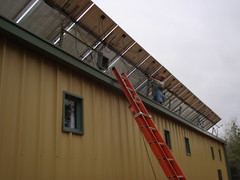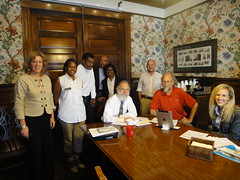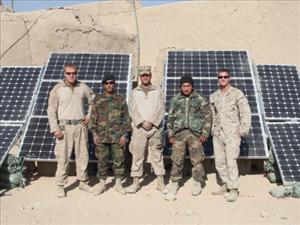Back
in 2009 we installed solar panels on our farm workshop.
 At the time the closest certified solar installer I could find was in Marietta.
Four years ago there were 4 in the state.
now there are forty.
And that’s in a state that’s trailing
North Carolina
and even
New Jersey
in solar installations.
At the time the closest certified solar installer I could find was in Marietta.
Four years ago there were 4 in the state.
now there are forty.
And that’s in a state that’s trailing
North Carolina
and even
New Jersey
in solar installations.
Also, I applied some weeks back for a USDA REAP grant for solar
for Okra Paradise Farms.

 Why Hannah Solar?
Because they had demonstrated capability by installing the
Wiregrass Solar plant in Valdosta
and because they had their ducks lined up in a row about that grant application.
The REAP grant plus federal and state rebates will pay for around 90%
of the cost of this additional solar installation.
Sure, I’ll end up paying the difference out of pocket,
but the whole thing will end up net positive in 3-7 years.
What else can you say that about with any certainty:
a car, a house, stocks, even a job?
Why Hannah Solar?
Because they had demonstrated capability by installing the
Wiregrass Solar plant in Valdosta
and because they had their ducks lined up in a row about that grant application.
The REAP grant plus federal and state rebates will pay for around 90%
of the cost of this additional solar installation.
Sure, I’ll end up paying the difference out of pocket,
but the whole thing will end up net positive in 3-7 years.
What else can you say that about with any certainty:
a car, a house, stocks, even a job?
And before anybody starts griping about subsidies, remember
fossil fuels get 12 times the subsidies of renewable energy.
There is private venture capital available
for large-scale solar projects right now
(here’s one example).
Gadsden County, Florida and National Solar Power just announced
a large-scale solar project mostly privately funded
only about a hundred miles west of here.
For house-scale solar projects, financing is a business opportunity
for some local bank or banks.
Gadsden County, Florida, got their project because
they got on with doing something.
Wednesday, Sherry Wheat drove down from Atlanta to help at the
 Renewable and Sustainable Energy Network forming up at the Chamber of
Commerce’s Opportunity Central.
The participants are trying to do something about educating
people about renewable energy hereabouts.
Renewable and Sustainable Energy Network forming up at the Chamber of
Commerce’s Opportunity Central.
The participants are trying to do something about educating
people about renewable energy hereabouts.
That same day Blankenship’s LTE also asked the silly question, “what it would cost to keep one freezer running.” He had trouble finding an answer because nobody really sells solar at the per-freezer level; it tends to be for household or larger. That’s like asking how much coal would it take to run a single freezer. Except, wait, for solar no fuel is required! Dr. Noll has already provided pointers to where to find quotes for house-scale solar power.
Let’s go beyond Blankenship’s nit-picking and look at the big picture.
Renewable and sustainable energy is a matter of national security,
 as the U.S. military discovered in Afghanistan,
where trucking in oil to run air conditioners in the desert
was a major security risk until they
switched to solar electricity generation instead.
Who wants to owe our power generation to Saudi Arabia,
where they flog women for driving?
Who wants to fight another land war in Asia for oil?
as the U.S. military discovered in Afghanistan,
where trucking in oil to run air conditioners in the desert
was a major security risk until they
switched to solar electricity generation instead.
Who wants to owe our power generation to Saudi Arabia,
where they flog women for driving?
Who wants to fight another land war in Asia for oil?
Which is cheaper,
- Financing solar for your house, which costs less than a car out of pocket and starts paying back in 15 years or less,
- Or buying an extra car you don’t need that depreciates anyway,
-
 Or paying for power from
the nation’s dirtiest coal plant near Macon
plus
the extraordinary negative side of coal mining,
Or paying for power from
the nation’s dirtiest coal plant near Macon
plus
the extraordinary negative side of coal mining,
- Or paying increasing fees to Georgia Power for building its two new nukes, including any cost overruns?
The real questions are:
- How can we afford to continue subsidizing fossil fuel companies to pollute while they make record profits for any companies in history?
- How can we afford to continue paying for wars for oil?
- How can we afford not to get on with renewable and sustainable energy, especially solar?
- Why not use the south Georgia sun to lead in the fastest growing industry in the world?
- And what are you doing to help?
-jsq
Short Link: